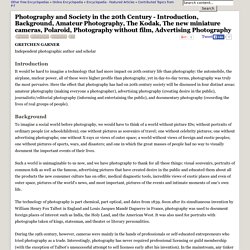

Digital Photography School - Digital Photography Tips and Tutorials. Shutterbug Home. Digital Photo. Digital Camera News, Reviews, Tips and Techniques. A history of photography in art and science (infographic) Ever wondered about the history of photography and its balance between art and science?

This fantastic cheat sheet compiled by Clifton Cameras traces some of the key moments in the history of photography and the great photographers who made leaps forward from artistic and scientific standpoints. In particular, this infographic explores the history of photography from the viewpoint of the Royal Photographic society by firstly taking a look at its forerunners The Edinburgh Calotype Society (formed in 1847) and the Leeds Photographic Society (formed in 1852), as well as key figures in photographic history such as Louis-Jacques-Mandé Daguerre and Henry Talcot.
The infographic then moves on to trace the divide between science and art in the early days of the society and finishes off with a look at some stats about the RPS today. Click on the infographic to see the larger version. The 55 best photographers of all time. Photography and Society in the 20th Century - Introduction, Background, Amateur Photography, The Kodak, The new miniature cameras, Polaroid, Photography without film, Advertising Photography - JRank Articles.
GRETCHEN GARNER Independent photographic author and scholar Introduction It would be hard to imagine a technology that had more impact on 20th century life than photography: the automobile, the airplane, nuclear power, all of these were higher profile than photography, yet in day-to-day terms, photography was truly the most pervasive.

Aperture and Depth of Field. Depth of Field Depth of Field (DOF) is the front-to-back zone of a photograph in which the image is razor sharp.

As soon as an object (person, thing) falls out of this range, it begins to lose focus at an accelerating degree the farther out of the zone it falls; e.g. closer to the lens or deeper into the background. With any DOF zone, there is a Point of Optimum focus in which the object is most sharp. There are two ways to describe the qualities of depth of field - shallow DOF or deep DOF. Shallow is when the included focus range is very narrow, a few inches to several feet. Aperture. Still Life Photography. In today’s photo tip, we begin a study of still life photography techniques.

We’ll start out with a still life photography definition that will describe the two main areas of still life photography. “Gala Apples” captured by Jamar L. Cotton (Click image to see more from Cotton.) Learning how to shoot still life photos should make you start jumping up and down with joy. Why? You’ll get much better at seeing how light and shadow affect a photograph–how form comes into play, composition, harmony, and on and on. If you can figure out how to arrange the proverbial bowl of fruit into an interesting composition–and get comfortable doing it–you will start to recognize which shapes and colors work together. History of Cameras: Illustrated Timeline. Email Photographic cameras’ roots go deep.

Everything started with the camera obscura, and continued with Daguerreotypes, 35mm cameras, digital cameras and camera phones. Photo by Andrew Illarionov Now we offer you to learn more about the photo cameras ‘way’ through ages and generations of photographers. Due to the popularity of this post, it was updated by Chris Ford. The first pinhole camera (also called the Camera Obscura) was invented by Alhazen (Ibn Al-Haytham). The Daguerreotype Camera was announced by the French Academy of Sciences.
The first American patent issued in photography to Alexander Wolcott for his camera. The panoramic camera patented by Thomas Sutton. Oliver Wendell Holmes invents stereoscope viewer. George Eastman patents Kodak roll-film camera. History of Photography and the Camera. Updated October 05, 2015. continue reading below our video Niepce placed an engraving onto a metal plate coated in bitumen, and then exposed it to light.

The shadowy areas of the engraving blocked light, but the whiter areas permitted light to react with the chemicals on the plate. When Niepce placed the metal plate in a solvent, gradually an image, until then invisible, appeared. However, Niepce's photograph required eight hours of light exposure to create and after appearing would soon fade away. In 1839 after several years of experimentation and Niepce's death, Daguerre developed a more convenient and effective method of photography, naming it after himself - the daguerreotype. Daguerre's process 'fixed' the images onto a sheet of silver-plated copper. In 1839, Daguerre and Niepce's son sold the rights for the daguerreotype to the French government and published a booklet describing the process.
Talbot sensitized paper to light with a silver salt solution. Digital Photographer - Photo Galleries, Tutorials, Reviews & Advice.